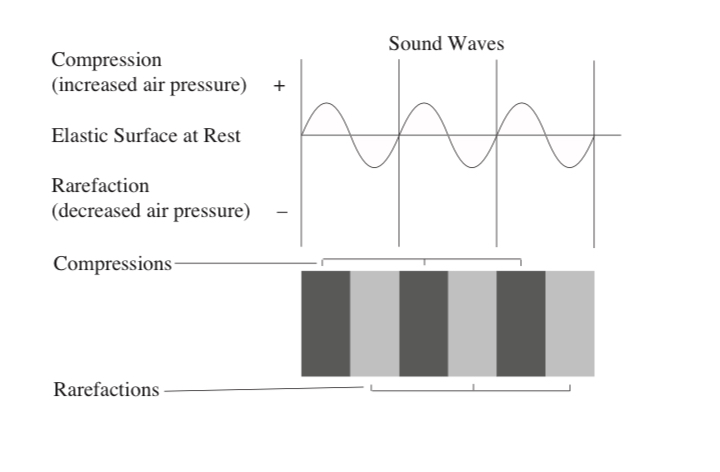Music Theory Vocabulary: Introduction
0.0(0)
0.0(0)
Card Sorting
1/19
Study Analytics
Name | Mastery | Learn | Test | Matching | Spaced |
|---|
No study sessions yet.
20 Terms
1
New cards
Sound
The sensation perceived by the organs of hearing when vibrations (sound waves) reach the ear.
2
New cards
Vibration (Sound Wave)
The periodic motion of a substance. Produced by one complete cycle of compression and rarefaction.

3
New cards
Compression
Increased air pressure
4
New cards
Rarefaction
Decreased air pressure
5
New cards
Frequency
The number of compression-rarefaction cycles that occur per unit of time (usually 1 second).
6
New cards
Pitch
The lowness or highness of a sound. Variations in frequency are perceived as variations in pitch.
\
Greater frequency = higher pitch; lower frequency = lower pitch.
\
Greater frequency = higher pitch; lower frequency = lower pitch.
7
New cards
Tone
A musical sound of definite pitch.
8
New cards
Intensity (Amplitude)
Heard as the loudness or softness of a pitch.
\
In acoustics (the science of sound) intensity is the amount of energy affecting a vibrating body. Intensity is measured in decibels.
\
Gradations of intensity are indicated by dynamics.
\
In acoustics (the science of sound) intensity is the amount of energy affecting a vibrating body. Intensity is measured in decibels.
\
Gradations of intensity are indicated by dynamics.
9
New cards
Decibel
Unit of measurement for intensity/amplitude on a scale from 0-130.
10
New cards
Duration
The length of time a pitch, or tone, is sounded.
\
Meter and rhythm are terms used to describe patterns of duration.
\
Meter and rhythm are terms used to describe patterns of duration.
11
New cards
Meter
Regularly recurring pulses of equal duration, generally grouped into patterns of two, three, four, or more with one of the pulses in each group accented.
12
New cards
Beats
Patterns of strong and weak pulses within a meter.
13
New cards
Duple Meter
A basic two-beat meter. All other meters are a combination of duple and triple meters.
14
New cards
Triple Meter
A basic three-beat meter. All other meters are a combination of duple and triple meters.
15
New cards
Rhythm
A pattern of uneven durations.
While the steady beats of the meter combine to form measures, a rhythm may be a pattern of almost any length.
While the steady beats of the meter combine to form measures, a rhythm may be a pattern of almost any length.
16
New cards
Timbre
The tone quality or color of a sound.
\
This sound quality is determined by the shape of the vibrating body, its material (metal, wood, human tissue), and the method used to put it in motion (striking, bowing, blowing, plucking). It is also the result of the human ear’s perception of a series of tones called the harmonic series, which is produced by all instruments.
\
This sound quality is determined by the shape of the vibrating body, its material (metal, wood, human tissue), and the method used to put it in motion (striking, bowing, blowing, plucking). It is also the result of the human ear’s perception of a series of tones called the harmonic series, which is produced by all instruments.
17
New cards
Harmonic Series
A harmonic series includes the various pitches produced simultaneously by a vibrating body.
This physical phenomenon results because the body vibrates in sections as well as in a single unit. A string, for example, vibrates along its entire length as well as in halves, thirds, quarters, and so on.
This physical phenomenon results because the body vibrates in sections as well as in a single unit. A string, for example, vibrates along its entire length as well as in halves, thirds, quarters, and so on.
18
New cards
Harmonics (Partials)
The pitches produced simultaneously by the vibrating sections of the vibrating body.
19
New cards
The Fundamental
The first partial. Constitutes a musical tone alongside a series of partials.
The lowest frequency, perceived as the loudest. The ear identifies the fundamental as the specific pitch of a musical tone.
\
Individual partials are not distinguished separately. Instead, they are heard by the ear as a blend that characterizes timbre.
The lowest frequency, perceived as the loudest. The ear identifies the fundamental as the specific pitch of a musical tone.
\
Individual partials are not distinguished separately. Instead, they are heard by the ear as a blend that characterizes timbre.
20
New cards
Music
An art of sound and time